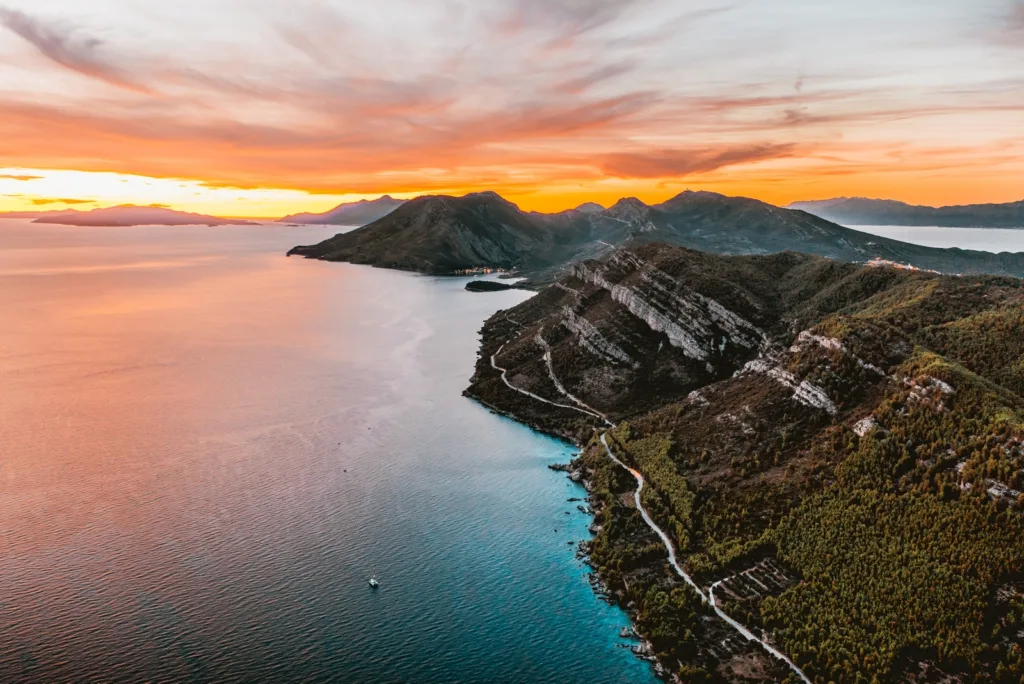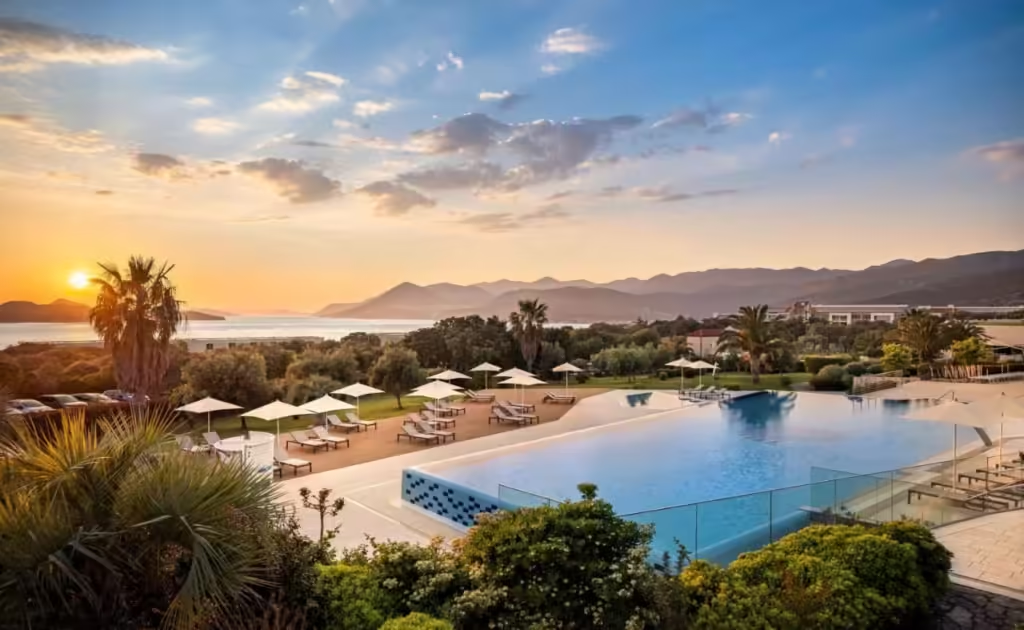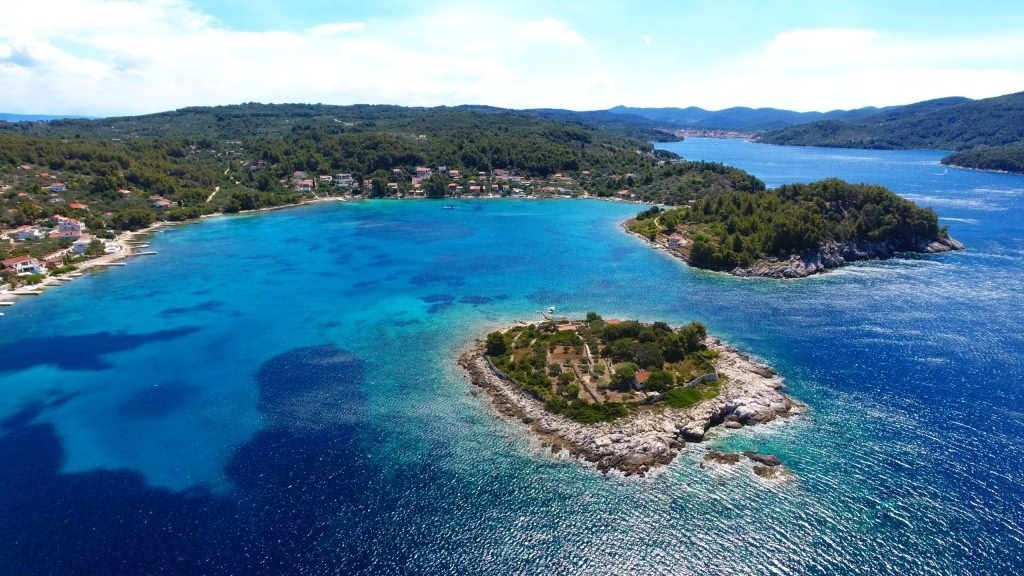Pelješac is Croatia’s wild, sunlit peninsula in Dubrovnik–Neretva County. Vineyards cling to stone terraces and medieval walls guard a salt town, while the channel between Orebić and Korčula funnels wind and light. You can taste oysters at their source, then watch sails skim across a blue afternoon. Distances are short, experiences are big.

Table of Contents
ToggleWhere Is Pelješac and Why Go
Pelješac stretches northwest from the mainland south of Dubrovnik. It is the second‑largest Croatian peninsula. The main road is the D414, running from Ston to Orebić and Trpanj. The new Pelješac Bridge connects the mainland at Komarna with the peninsula near Brijesta, making the drive smooth and border‑free.
Why go:
Wine with protected origins: Dingač, Postup and Ponikve.
Seafood culture: Mali Ston oysters and saltworks heritage.
Reliable wind for summer water sports around Viganj and Kućište.
Beaches in quiet coves. Some sandy. Many pebble with clear water.
Short hops to Korčula and Mljet by ferry.
Getting In and Around
By Car
The Pelješac Bridge is the simplest entry point. It bypasses the Neum corridor and saves time. Drive times from Dubrovnik are short outside peak hours. Parking is easiest in Orebić and Ston. In small coves, arrive early.
By Ferry
Three car ferries link Pelješac with nearby islands and the mainland:
Orebić – Dominče (Korčula): frequent, short crossing, ideal for a Korčula day trip.
Trpanj – Ploče: useful if you come from Split or Makarska Riviera.
Prapratno – Sobra (Mljet): the jump‑off for Mljet National Park.
Foot passengers also use local boats in season. Ferry schedules are seasonal and can be affected by weather, so confirm timetables before travel.
By Bus and Bike
Coastal buses connect Dubrovnik with Ston and Orebić. Schedules are seasonal. Cyclists love Pelješac. The EuroVelo 8 route grazes the peninsula. Side roads rise and fall with sea views. Surfaces are decent. Traffic is lighter than on the coast road.
Ston and Mali Ston: Walls, Salt and Oysters
The Ston Walls
The stone ramparts link Ston with Mali Ston across the hillside. The walk is scenic and not too hard if you pace yourself. Steps are many, so bring water. Early morning offers shade and open views of salt pans and bays.
How to do it:
Start in Ston or Mali Ston depending on your parking.
Buy a ticket at the gate.
Wear grippy shoes. Some stairs are steep.
Plan 60–90 minutes with photo stops.
Ston Saltworks
Salt shaped Ston. The pans form a neat geometry of shallow pools. You can walk the edges and watch workers rake crystals in summer. Small tastings explain the process. Fleur de sel is the delicate top layer. It pairs well with local olive oil and tomatoes.
Mali Ston Oysters
Mali Ston Bay is famous for European flat oysters. Boats take you out to taste oysters fresh from the farm. The brackish water from nearby springs adds a clean mineral note. Many visitors time a trip for the March Oyster Festival. Outside March, you can still book a boat and a platter. Add a glass of Pošip or Rukatac. Life slows down.
Wine Country: Dingač, Postup and Ponikve
What Makes Pelješac Wine Special
The sun hits south‑facing slopes. Stone retains heat into the evening. Sea light reflects onto the vines. Plavac Mali, the key grape, thrives here. The result is intense reds with dark fruit, herbs and salt‑kissed edges.
Dingač (PDO)
Dingač is a protected designation. Vines cling to a dramatic mountainside above the Adriatic. The aspect is steep and challenging. Harvest is manual and hard. The wines are powerful yet complex.
Tasting notes to expect:
Ripe plum and black cherry.
Dried fig, Dalmatian herbs and a hint of sea spray.
Firm tannins and warming finish.
Postup (Protected since 1967)
Postup sits a little west, above the channel. The slope is less extreme. Wines feel slightly fresher. They suit seafood stews and grilled lamb.
Ponikve (PDO)
Ponikve is smaller and gaining attention. Producers focus on clarity and place. Ask for single‑parcel bottlings if you see them.
The Potomje Tunnel and Scenic Drive
A narrow tunnel links Potomje to the Dingač slopes. Drive slowly and yield with care. The reward is a road carved into cliffs with open sea views. Do not rush this section. Pull into signed bays for photos. Then continue to Trstenik or Žuljana for a swim.
Responsible tasting: appoint a sober driver or book a transfer. Many cellars offer short, focused flights.
Orebić and the Channel
Orebić Town
Orebić lines a gentle bay with a working marina. Cafés face the water. The promenade is flat and easy. Families like the shallow beaches to the east.
Korčula Day Trip
The ferry from Orebić to Dominče lands near Korčula Town. Buses or taxis cover the last kilometers. Spend a half day in the old town, then return for a sunset swim at Orebić.
Monastery of Our Lady of Angels
A short hill drive above Orebić brings you to a Franciscan monastery. The viewpoint frames sailboats tacking between Pelješac and Korčula. Late afternoon light is beautiful. Dress modestly and keep voices low.
Sveti Ilija Hike
The 961‑meter summit towers above Orebić. Trails start near the town and climb through pine and rock. Carry water and start early in summer. The view over the channel and Korčula is worth the effort. On windy days, watch footing near the top.
Beaches: From Sandy Prapratno to Hidden Pebble Coves
Prapratno
A rare sandy cove curves below olive slopes near Ston. The sea is shallow and warm in summer. Families love it. The cove also hosts the pier for the Mljet ferry, so expect some traffic at boarding times.
Divna
Divna sits north of Trpanj. The cove is pebbly with bright, clear water. The backdrop is wild and green. Arrive early for parking. Bring reef shoes if waves are up.
Žuljana and Vučine
Žuljana is a laid‑back village with several beaches. Vučine cove is sheltered and great for snorkeling. Pine shade helps in midsummer. The sea floor near the rocks hosts small fish and urchins. Swim with care.
Other Spots
Trstenik: small crescent beach with a harbor vibe.
Mokalo: tiny, photogenic coves near Orebić.
Duba: far north, facing the mainland, with crystal water.
Beach tips:
Carry cash for small parking lots.
Bring shade. Coastal sun is strong.
Always pack water and a bag for your waste.
Windsurfing and Kitesurfing: Viganj and Kućište
The afternoon Maestral funnels between Pelješac and Korčula. Viganj turns breezy days into a playground. Schools line the shore with boards and kites. Beginners start near the beach. Intermediates fly farther into the channel. Mornings are calmer for first lessons. Afternoons bring stronger wind for experienced riders.
What to know:
July and August see the steadiest thermals.
Wear a shorty wetsuit on cooler days.
Watch for ferry traffic and give way.
Secure boards and kites when gusts arrive.
Kućište next door shares the same wind window. Many sailors split time between both spots.
Where to Stay on Pelješac
Best Bases by Interest
Ston & Mali Ston: For first‑timers and food lovers. Close to the bridge and oysters. Historic feel. Drive to beaches.
Orebić & Kućište/Viganj: For families, water sports and Korčula day trips. Promenades, shallow beaches and lively evenings.
Trstenik: For couples and wine fans. Small crescent beach. Near Dingač slopes. Quiet nights and limited shops.
Žuljana & Vučine: For snorkel coves and pine shade. Simple, local life. A car helps for supplies.
Trpanj: For arrivals from Ploče. Handy for Divna and Duba. Local feel with small beaches.
Prapratno: For families who want sand. Easy swim entry. Busy at Mljet ferry times.
Accommodation Types
🔍Seafront hotels: Easy for families. Book early for July–August.
🔍Guesthouses and apartments: Most common. Great value in spring and autumn.
🔍Agroturizam stays: Rooms on farms or wineries. Quiet and close to vineyards.
🔍Camps and glamping: Near Orebić and Žuljana. Pick shady plots in midsummer.
Booking Tips
Split a week into two bases: Ston area + Orebić or Viganj.
Ask about parking and beach distance in meters.
For wine touring, base near Potomje or Trstenik.
For Korčula day trips, sleep in Orebić or Kućište.
Bring some cash for tourist tax and extras.
Check ferry noise if staying near a pier.

Food and Drink: From Sea to Stone Terrace
Oysters and Shellfish
Order raw oysters with lemon or a light vinaigrette. Try mussels buzara, a simple garlic‑tomato stew. Add warm bread. Pair with Pošip or a dry Rukatac.
Meat and Comfort Plates
Dalmatian pašticada, slow‑cooked beef in a rich sauce, appears in inland konobas. Grilled lamb and young goat are common for Sunday lunches.
Sweet Things
Try rožata, a caramel custard, or fritule, small fried dough bites. Local honey and almonds also feature in cakes.
Wine Pairing Ideas
Oysters + sparkling Pošip.
Grilled fish + citrusy Pošip.
Octopus salad + skin‑contact white.
Peka lamb + Postup.
Aged cheese + Dingač.
Always ask for the house olive oil. It often comes from groves just up the road.
Short Itineraries That Work
One Perfect Day
Morning: drive across the Pelješac Bridge to Ston. Walk the walls while it is cool.
Late morning: tour the saltworks. Pick up fleur de sel.
Lunch: oyster tasting in Mali Ston.
Afternoon: swim at Prapratno or Žuljana.
Evening: sunset glass of Dingač on a terrace. Sleep in Orebić or Trstenik.
Two to Three Days
Day 1: Ston walls, saltworks and oysters. Beach time at Prapratno. Dinner in Ston.
Day 2: Drive the Potomje tunnel to the Dingač slopes. Tastings at two small cellars. Lunch in Trstenik. Swim at Vučine. Overnight in Orebić.
Day 3: Morning ferry to Korčula Town. Explore alleys and the cathedral square. Return for a sunset at the monastery viewpoint.
Five to Seven Days
Add a windsurf lesson in Viganj.
Hike Sveti Ilija on a cooler day.
Take the Prapratno ferry for a Mljet day trip.
Explore the far north near Duba and Divna.
Cycle an early‑morning loop above Orebić for channel views.
When to Visit
Spring (April–May): green hills, mild seas, fewer crowds. Oyster season peaks in March, quality stays high into spring.
Summer (June–August): warm water and long days. Expect busy beaches and steady winds. Book rooms and tastings early.
Autumn (September–October): harvest time in the vineyards. The sea stays warm. Days are bright and clear.
Winter: quiet and local. Some restaurants close. Walks and drives shine on clear days.
Practical Tips and Safety
Drive slowly on cliff roads and through the Potomje tunnel.
Carry cash for smaller car parks and beach kiosks.
Tap water is safe to drink.
The sun is strong. Use reef‑safe sunscreen and a hat.
In coves, watch for sea urchins near rocks.
Wildfires can occur in hot, dry spells. Obey closures.
Ferry timetables can change with weather. Always confirm before heading to the pier.
Sustainable Travel on Pelješac
Refill bottles at accommodation before beach trips.
Choose tastings at small, family cellars.
Keep distances short. Combine errands to reduce driving.
Respect shellfish farms and marked private jetties.
Pack out all rubbish from coves and viewpoints.
FAQs
Is the Pelješac Bridge open year‑round?
Yes. It provides a direct, border‑free link to the mainland.
How long are the Ston Walls?
About five and a half kilometers. Expect steps and views.
Where can I try oysters?
In Mali Ston. Book a boat tour and tasting. March hosts a festival, but oysters are available most of the year.
What is the difference between Dingač and Postup?
Both are Plavac Mali from steep coastal slopes. Dingač is often richer. Postup tends to be a touch fresher.
Are there sandy beaches on Pelješac?
Yes. Prapratno is a sandy cove near Ston. Most others are pebble with clear water.
Can beginners windsurf in Viganj?
Yes. Schools offer beginner gear in the morning. Afternoons suit intermediates and experts.
Are Korčula and Mljet realistic day trips?
Yes. Orebić ferries serve Korčula and Prapratno serves Mljet. Check seasonal schedules and weather before travel.
What should I pack?
Reef‑safe sunscreen, a hat, water shoes for pebbly entries, and a light windbreaker for channel evenings.
Do I need to pre‑book wine tastings?
In summer, yes. Book small tastings and allow time to drive slowly between sites.
Conclusion
Pelješac blends history, wine, oysters and wind into one compact peninsula. From the Ston Walls and saltworks to Korčula ferries and sandy coves, it offers varied travel days with short distances and strong flavors.
Disclosure: This page may contain affiliate links. This means that we get a small commission from any purchase you make, at no additional cost to you!

